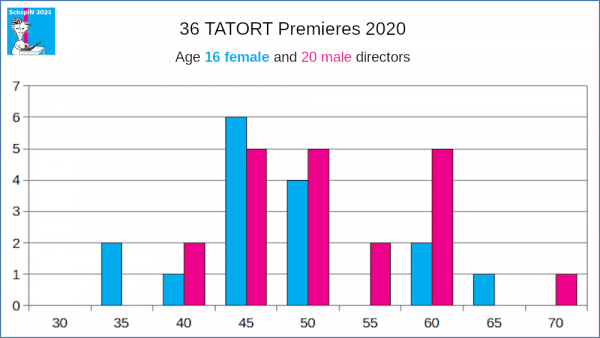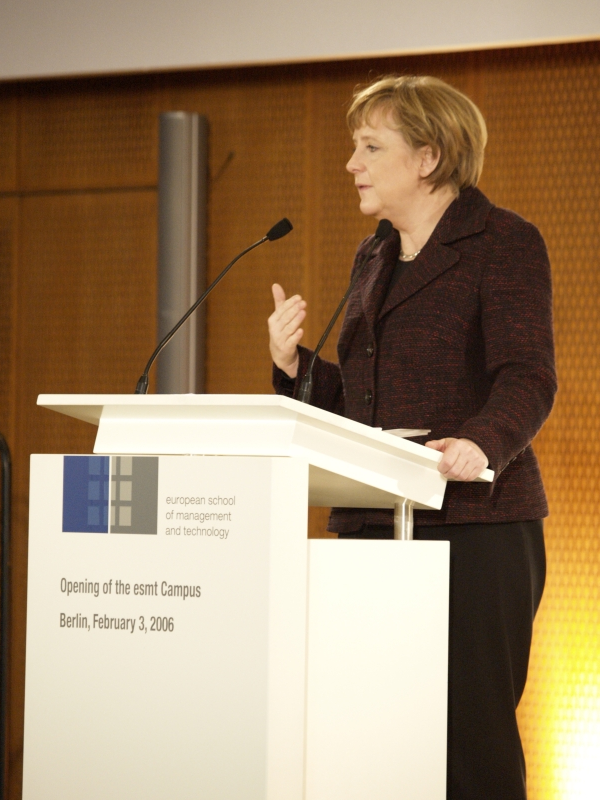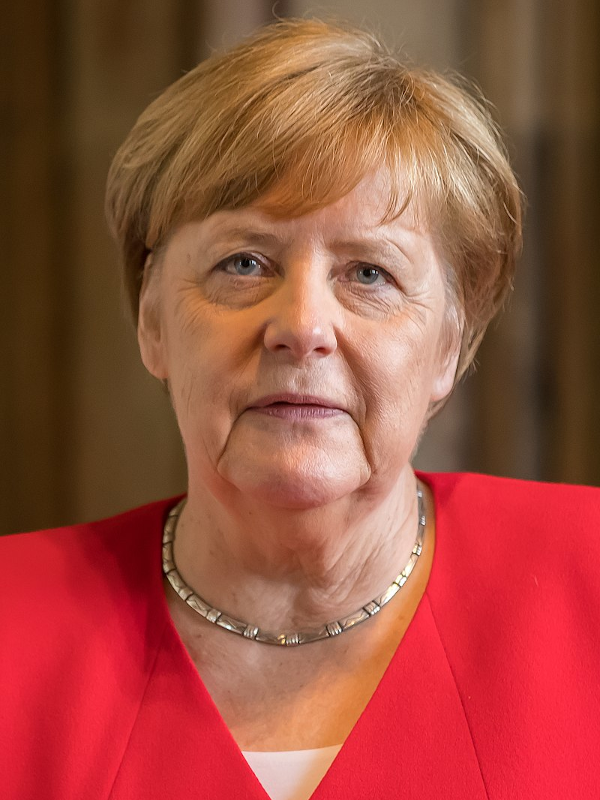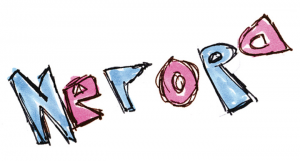Yesterday I was standing at the checkout in an organic supermarket. The cashier asked the customer in front of me if she had a student card – that must have given her a discount. The woman went completely berserk with pleasure for having been mistaken for a student. She was wearing a mask of course and a beanie, but from her eyes, among other things, I would have guessed she was easily in her late 30s or early 40s. Anyway. She was beaming all over, “This is the most beautiful thing I’m going to experience today!” It was 10:45 a.m.. What a prospect.
Hardly anyone wants to be old, people are turning 60 years young, old has become a dirty word. Actually, not always, in German. There‘s the phrase „Was geht ab, Alter?“ / “What’s up, dude?” – originally from youth language. Alter (dude) literally translates to old man. I’ve never heard the word “Alte” (old woman) in a similar context. Have you?
Old Women, visible. In Film and Television.
Being thought of as younger is enormously important for many people. Not only for women, by the way, but especially for them, because youth mania with everything that goes with it, partly presented by society, partly by the media, leaves its mark. The Hamburg-based initiative Pink Stinks (“Magazine, campaign office and an educational organisation against sexism.”) has been addressing the connection between a format like GERMANY’S NEXT TOP MODEL and slimness mania up to bulimia among young female viewers for years.
Age and eternal youth are also topics in the film and television industry. If a – famous – actress is over 50 or 60 or 70, it is always emphasised that she looks at least ten, if not twenty years younger. Famous older actresses play much younger roles (e.g. still a pregnant woman at 53), which – if you didn’t know their age – they could often pass as, because they work on their appearance and / or have it worked on and look tremendous. When older actresses like Iris Berben, Senta Berger or Hannelore Elsner once showed a grey hair in a role, it was highlighted as a special achievement.
Getting our headshots done is not cheap and a big deal, before and in between the hair and make-up is done and changed and the results are digitally done over afterwards. (I’ve been an actress for so long that I still remember photo sessions without a make-up artist present…).
Actresses are predominantly very fit, slim to very slim, – Marlene Dietrich is credited with the quote: “Being an actress means always leaving the table hungry.” They are slim and wrinkle-free, and for the most part they stay that way as they age. Unlike women outside the acting industry. And men. Normally, as they age, they all put on a little weight around the hips, bags under the eyes become more prominent, chins softer, voices darker, hair whiter and thinner. For women, this can be related to the menopause, but for everyone it can also be related to a change in metabolism – we need less food, i.e. if we eat the same amount as before, we gain weight, or a change in lifestyle or whatever.
This is not the case with actresses. If they have to grow older, then at least they shouldn’t be visible. In more ways than one. They 1) don’t look like ‘normal women’ who age. But 2) they still appear on screen much less than their colleagues of the same age, who often look much older and are sometimes chubbier. And there is also a third factor: although actresses look young and younger, female roles are often cast even younger, a 40-year-old is played by a 30 to 35-year-old, etc. etc.
And when older women are the centre of a German TV film, the parts are often written unrealistically, they live in very well to do circumstances, in fancy houses or villas, are expensively and fashionably and always impeccably dressed, without any creases in their garments. One of the only few exceptions I can think of is Barbara Morawiecz as the very touching Mrs. Wernicke in the Berlin Tatort HITCHCOCK UND FRAU WERNICKE (2010). She plays a pensioner who lives in a rented flat. Morawiecz was 71 years old when the film was shot.
Unfortunately, public television still argues very strongly with the alleged will of the audience – as evidenced by “TV ratings”. And the makers interpret who the viewers supposedly want to see and what they don’t want to see. I think this a quite wrong and even dangerous approach, but that‘s a topic for another day.
I’ve written about this many times already:
SchspIN and Age Research
Actresses who pass 40 have fewer job opportunities (in film, TV and streaming) than their male colleagues, simply because there are far fewer roles for women. Also as voice actresses dubbing films, because this is not only the case in Germany (ageism).
This professional reality, which I am also affected by, was one of the reasons to start my analyses and this blog in 2013; I‘ve examined it again and again with random samples and also written about age phenomena among women and men in front of the camera in other ways. Here is a selection of articles:
- 27.2.13: On Actresses and Other Working Women
- 28.3.13: How Old are the Sisters Grimme?
- 31.7.13: The Perfect Age for German TV
- 7.8.13: Are They the News? Old Men and Young Women
- 2.1.14: For Heaven’s Sake: Look at the Ratings!
- 14.3.14: Age – A Picture is Worth a Thousand Words
- 11.9.14: The Standards for Public Broadcasting
- 26.9.18: Cleverer Girls
- 11.12.18: THE SPLIT – Diversifying Casts
- 31.12.19: Once Again – TV’s Crime Scene TATORT
- 28.8.20: WIFT Germany and SchspIN on Top Cop Drama. Part 2: Directors
- 22.12.20: Karin Hanczewski – Inside Story
Directors and Age
In the above-mentioned article of 28.8.20 it was discussed in passing: Age discrimination can also affect other women filmmakers, writers, cinematographers, costume designers and so on, even women directors. I evaluated the age of TATORT directors in the first half of 2020. Here, as an update for the whole year, is the age distribution of the 16 female directors and 20 male directors of the 36 TATORT premieres (TATORT = crime scene, Germany‘s top cop drama):
The high number of relatively young female directors is quite striking, many directed their first TATORT, 56% are under 45 years old. Will they continue to work in this format over the decades? And why are so few older – experienced in directing television movies! – female directors? Only three women (19% of all directors) were over 50, compared to eight men (40% of all directors). The oldest man was 70, the oldest woman 62. That doesn’t make any sense. It would also be interesting to know the directors’ salaries at this point, but for one thing that goes beyond the topic, and for another they are not publicly available.
On the subject of directing and age, here’s another thought: director and screenwriter Christian Petzold (*1960) wrote and directed several very successful feature films from 2003 to 2014 with Nina Hoss (*1975) as the female lead. Since 2018, Paula Beer (*1995) has played his female leads. Is there the reverse case, an artist whose female protagonists, whose muses grow older? Not ageing together with him, but growing older by leaps and bounds?
Visibility, 47+
Professor Elizabeth Prommer (Institute for Media Research, University of Rostock), together with her colleagues Julia Stüwe and Juliane Wegner and their team, has just published an update to the study “Audiovisual Diversity? Gender Representations in Film and Television in Germany” from 2017: “Visibility and Diversity: Progress Study on Audiovisual Diversity” (actually, in German). The 23-page paper and also a 30-page presentation from 5 October can be downloaded from the Institute’s website.
Prommer et al. prove the continuing age discrimination of actresses in German television, among other things, by looking at age groups. As a positive piece of news, it should be noted that for the fictional television formats of the “two artificial weeks” of the study, which were first broadcast or produced in 2020, the ratio between male and female main characters (“Protagonists”) is almost balanced. However, this does not apply to the entirety of the roles.
Inspired – or maybe triggered? – by Prommer’s latest findings, Palais F*luxx, an online platform for women over 47, launched a campaign on Instagram, with the hashtag #sichtbarkeit47+ (visibility47+). They posted portraits of actresses over 47 under the heading Her we want to see! This is a very good idea. It’s important to stand up for actresses over 47, and they all, nope, we all deserve more and better roles.
It might be a good idea actually if the campaign showed more women who look like women in their mid-40s and older in our society. Maybe some of the #visibility47+ photos are already very old, or heavily retouched, or the people have had plastic surgery. Or they just have good genes. I don’t want to criticise any female colleagues, I know the pressure that is on women in the industry, among other things, in terms of appearance. But if we’re talking about representation and reflecting social reality, what’s the point of having more older women on fictional television who don’t look anything like women their age out there?
The next two pictures show Dr Angela Merkel receiving her certificate of dismissal a few days ago. First at the age of 51 shortly after her first inauguration as German Chancellor, and then her two years ago at the age of 65, which makes her basically a peer of some of the #visibility47+ actresses:
By the way: for me, the most convincing photo of the campaign on Instagram was a selfie with Elizabeth Prommer (born 65), Simone Glöcker (born 67), and probably Silke Burmester (born 66) in the background. (but I don’t know if you can see it without an Insta account).
We Should Be Seeing Them
In a few days I‘m going to publish a sequel to this blog text with the subtitle We should be seeing Women like These. I’ve started to compile pictures of women over 40, over 50, over 60, over 70. Many are female politicians – we had an election just now and besides, there are public domain pictures of them in Wikipedia – some female artists, some female scientists, a handful of actresses are also included. Since some of the photos are official, the women were of course made up and the pictures were certainly edited, which is perfectly fine. It’s just that the age diversity of the group will be much more graphic than it usually is in German fictional film and television.
The whole thing will take a while, though, because I want to bring the pictures to a uniform size and also add the copyrights information. I have mentioned several times that Wikipedia is not the most stable source. You have just seen the picture of 51-year-old Angela Merkel. If you download the photo from wikipedia, it says File, etc., created on 1 January 2006. On the photo you can see the inscription on the podium: Opening of the ESMT Campus, Berlin, February 3, 2006. See what I mean?
Addition 1.11.21: Here is the follow-up text with the photos of older women, across our society:
Old Women. Visibility. Part II
Walking on Crutches is Better than not Walking at all
Among other things, I invented the method NEROPA Neutral Roles Parity to fight the current disproportion of female and male roles (do visit the official website neropa.stieve.com). When applied to completed scripts – with the auxiliary question: “Does this character have to be male?” – it leads, via the neutral roles, to formerly male roles becoming female roles. This has the positive side effect that there are suddenly more female roles with names and also older female roles, because both existed with male roles. Women who are not only in a personal relationship context to a male figure, as wife, lover, mother or daughter. Of course, it is even better to apply the NEROPA principle from the start, when developing the story, writing the script, but improving an existing screenplay is better than leaving the films as male-biased as they are in most cases.
And the NEROPA fine-tuning that is done when the cast are put forward and hired also helps with the age question. Because here the auxiliary question is “Does this character have to be white, young, good-looking, heterosexual, flawless and slim?“, and so older actresses can also be suggested for roles without a fixed age.
“And Action!” More Actresses over 50 in Cinema, Streaming and TV.
The age topic is trending. Yesterday, two virtual events took place, organized by the German chapter of Woman in Film & Television (WIFT Germany) and the Götz George Foundation as part of HoF Plus at the Hofer Filmtage / Filmfestival Hof / South Germany. A Think Tank in the morning, a Tacheles Panel in the afternoon.
The morning event will begin with a short talk by Prof. Dr. Elizabeth Prommer, who will present the latest figures from the new edition of the study on audiovisual diversity in film and television in Germany. Afterwards, representatives from the areas of production, television editing, streaming editing, acting, directing, casting, PR and funding will sit down in several rounds of talks, including Leslie Malton (BFFS), Nina Haun (casting director), Lars Becker (script writer/director), Frank Tönsmann (editing, WDR), Zazie de Paris (acting), Ilknur Boyraz (acting), Anna Schöppe (HessenFilm film funding), Adriana Altaras (directing/acting), Nadja Malkewitz (producing, RTL), Iris Wolfinger (producing, Warner. Bros) and Petra K. Wagner (script writer/director). The moderators will include Knut Elstermann and Sandra Willmann. This is a closed event.
In the afternoon, the discussion will continue in another round at the “Tacheles Talk: More Actresses over 50 in Film, Streaming and Television”. After a welcome by Thorsten Schaumann (Hofer Filmtage), Marika George (Götz George Foundation) and Catherine Lieser (WIFT Germany), the actresses Adriana Alteras, Anke Sevenich, Anna Brüggemann and Simone Wagner will have their say under the moderation of Cornelia Köhler (WIFT).
It was a great event, also because representatives of the broadcasters were there. A press release on the think tank will be published today, followed by a position paper in the next few weeks. I will add both here. The recording of the lively 46-minute afternoon panel can be seen here!
In any case, there is a lot going on. And it is very positive that many different initiatives and individuals from in and outside the sector are taking up the issue of visibility of older women.
Two Things to watch, from France
First, a classic film with beautiful dialogue, also on women’s and men’s ages and mixed-age relationships: CACTUS FLOWER (1969) with Ingrid Bergmann, based on the French play FLEUR DE CACTUS by Pierre Barillet and Jean-Pierre Gredy.
And a great series from France: DIX POUR CENT / CALL MY AGENT! based on an idea by Fanny Herrero (four seasons so far since 2015) with Camille Cottin. Here, among other things, the age, appearance and career of actresses and also actors are a recurring theme.
Addendum:
And two series with old women at the centre to look out for:
- The Israeli series HAMISHIM – 50 (1 season, 8 episodes, 2019), centred on the initially 49-year-old Alona (Ilanit Ben-Yakoov).
- The British sitcom MUM (3 seasons, 18 episodes, 2016-19), centred on the initially 59-year-old Cathy (Lesley Manville).





